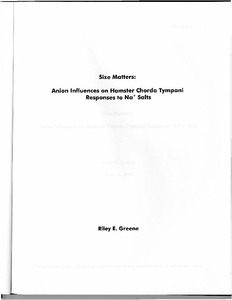| dc.rights.license | In Copyright | en_US |
| dc.creator | Greene, Riley Erickson | |
| dc.date.accessioned | 2023-10-20T18:01:23Z | |
| dc.date.available | 2023-10-20T18:01:23Z | |
| dc.date.created | 2000 | |
| dc.identifier | WLURG038_Greene_thesis_2000 | |
| dc.identifier.uri | https://dspace.wlu.edu/handle/11021/36515 | |
| dc.description.abstract | Over the past two decades, researchers have shown repeatedly that salt taste reception
depends, in numerous mammals, on the passive diffusion ofNa+ ions through apical, Na+selective
ion channels that can be blocked by the diuretic drug amiloride. Oral application of
amiloride suppresses the sodium responsiveness of the chorda tympani nerve, which innervates
taste buds in fungiform papillae on the anterior portion and in rostral foliate papillae on the sides
of the mammalian tongue. Using a powerful in vivo technique that permits control of the
electrical potential across the epithelium of the tongue, Ye et al. (1991) identified two
topologically separate Na+ sensing mechanisms in rat fungiform papilla taste buds. Despite
impressive gains in understanding Na+ sensing in the rat taste system, less is known about
sodium stimulus transduction in the hamster, which is widely used in studies of gustatory neural
coding. The present study used in vivo voltage clamping with simultaneous chorda tympani
neurophysiology to examine sodium sensing in the intact hamster. As expected, we observed an
anion influence on relative chorda tympani response magnitudes mediated through indirect anion
influences on apical Na+ channel properties. The anion effect on Na+ channel properties was
evident in the lower Km obtained for NaCl relative to NaGlu. Thus, our results suggest that
differences in the transepithelial potentials generated by NaCl and NaGlu, which originate from
differences in paracellular anion permeability, meditate stimulus-dependent modulation of apical
Na+ channel affinity. | en_US |
| dc.format.extent | 50 pages | en_US |
| dc.language.iso | en_US | en_US |
| dc.rights | This material is made available for use in research, teaching, and private study, pursuant to U.S. Copyright law. The user assumes full responsibility for any use of the materials, including but not limited to, infringement of copyright and publication rights of reproduced materials. Any materials used should be fully credited with the source. | en_US |
| dc.rights.uri | http://rightsstatements.org/vocab/InC/1.0/ | en_US |
| dc.title | Size Matters: Anion Influences on Hamster Chorda Tympani Responses to Na+ Salts | en_US |
| dc.type | Text | en_US |
| dcterms.isPartOf | WLURG038 - Student Papers | en_US |
| dc.rights.holder | Greene, Riley Erickson | en_US |
| dc.subject.fast | Taste -- Physiological aspects | en_US |
| dc.subject.fast | Chemical senses | en_US |
